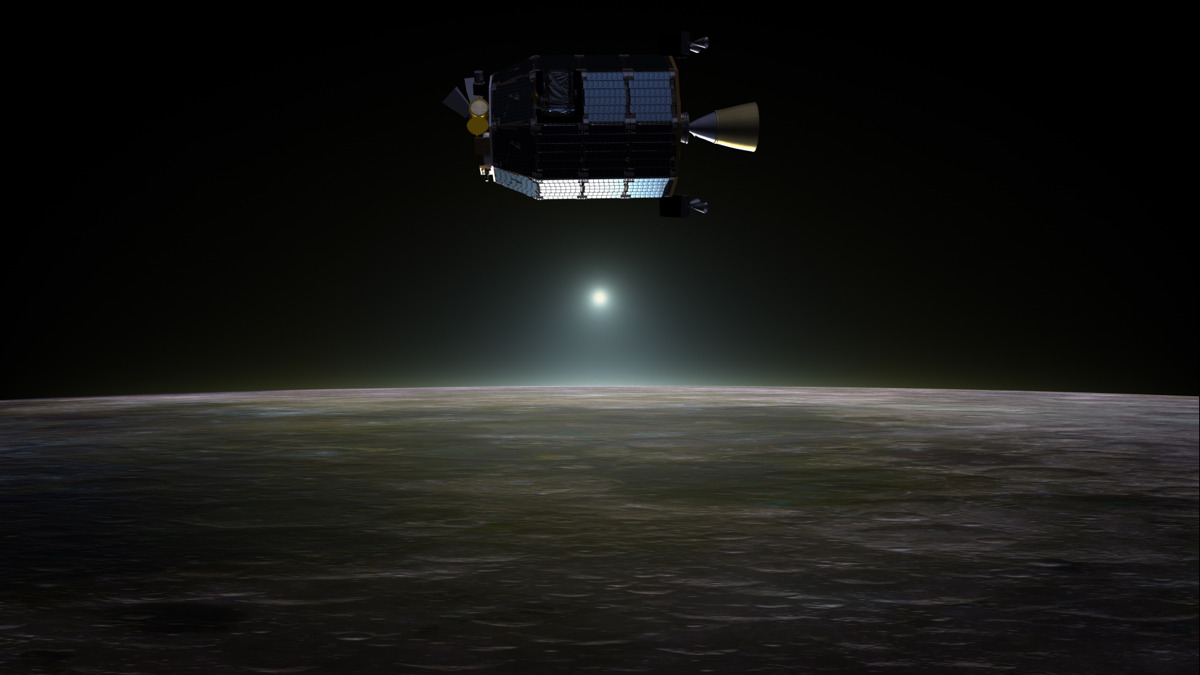
The moon doesn't have any gaudy casinos or buzzing diner signs, but it does have neon.
NASA's LADEE spacecraft has made the first-ever detection of neon in the wispy lunar atmosphere, which is properly known as an "exosphere" because it's so thin — about 100 trillion times less dense than that of Earth at sea level.
"The presence of neon in the exosphere of the moon has been a subject of speculation since the Apollo missions, but no credible detections were made," study lead author Mehdi Benna, of NASA's Goddard Space Flight Center in Greenbelt, Maryland, and the University of Maryland, Baltimore County, said in a statement. "We were very pleased to not only finally confirm its presence, but to show that it is relatively abundant." [The Moon: 10 Surprising Lunar Facts]
But the gas is not abundant enough on the moon to generate the famous neon glow, NASA officials said.
LADEE — which is short for Lunar Atmosphere and Dust Environment Explorer — studied the moon's exosphere from orbit for seven months, from September 2013 through the end of its mission in April 2014.
The spacecraft's Neutral Mass Spectrometer (NMS) instrument determined that the moon's atmosphere is composed mainly of helium, argon and neon. Most of this material comes from the solar wind, a diverse stream of particles flowing from the sun at about 1 million mph (1.6 million km/h). (Other elements in the solar wind tend to stick to the lunar surface, because they're more volatile than helium, argon and neon, NASA officials said.)
But the NMS data showed that some of the exospheric gases come from moon rocks, via the process of radioactive decay. About 20 percent of the helium probably came from the decay of uranium and thorium, and some of the argon from the decay of potassium-40 into argon-40, researchers said.
Get the Space.com Newsletter
Breaking space news, the latest updates on rocket launches, skywatching events and more!
"We were also surprised to find that argon-40 creates a local bulge above an unusual part of the moon's surface, the region containing [the dark volcanic plains] Mare Imbrium and Oceanus Procellarum," Benna said. "One could not help [but] notice that this region happens to be the place where potassium-40 is most abundant on the surface. So there may be a connection between the atmospheric argon, the surface potassium and deep interior sources."
LADEE's measurements also revealed that argon abundance changed by about 25 percent over the course of the spacecraft's mission, possibly as a result of outgassing caused by the Earth's strong gravitational tug, researchers said.
The new results, which were published May 28 in the journal Geophysical Research Letters, should give scientists a better understanding of exospheres in general, and that of the moon in particular, researchers said.
"It's critical to learn about the lunar exosphere before sustained human exploration substantially alters it," Benna said.
Follow Mike Wall on Twitter @michaeldwall and Google+. Follow us @Spacedotcom, Facebook or Google+. Originally published on Space.com.
Join our Space Forums to keep talking space on the latest missions, night sky and more! And if you have a news tip, correction or comment, let us know at: community@space.com.

Michael Wall is a Senior Space Writer with Space.com and joined the team in 2010. He primarily covers exoplanets, spaceflight and military space, but has been known to dabble in the space art beat. His book about the search for alien life, "Out There," was published on Nov. 13, 2018. Before becoming a science writer, Michael worked as a herpetologist and wildlife biologist. He has a Ph.D. in evolutionary biology from the University of Sydney, Australia, a bachelor's degree from the University of Arizona, and a graduate certificate in science writing from the University of California, Santa Cruz. To find out what his latest project is, you can follow Michael on Twitter.
